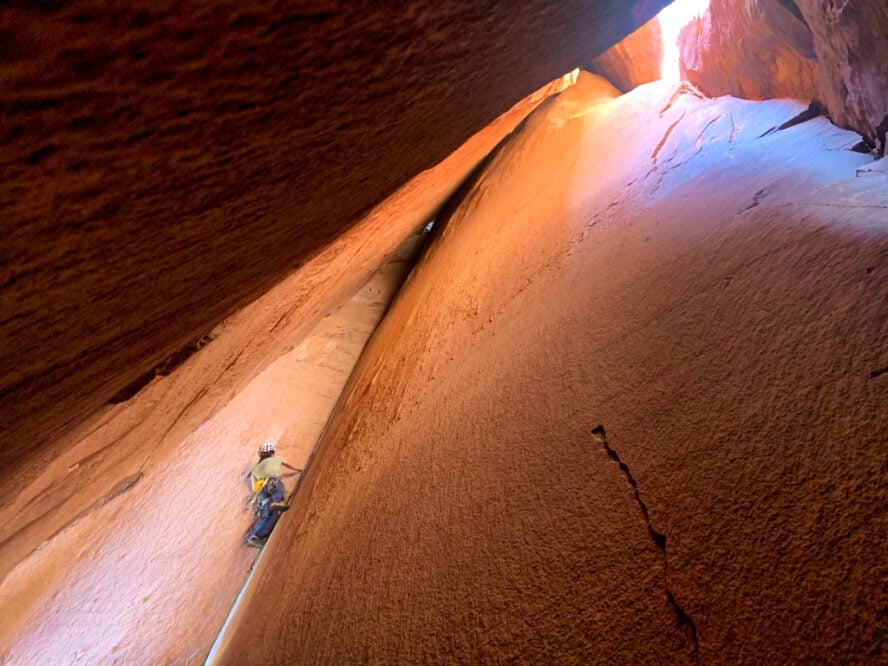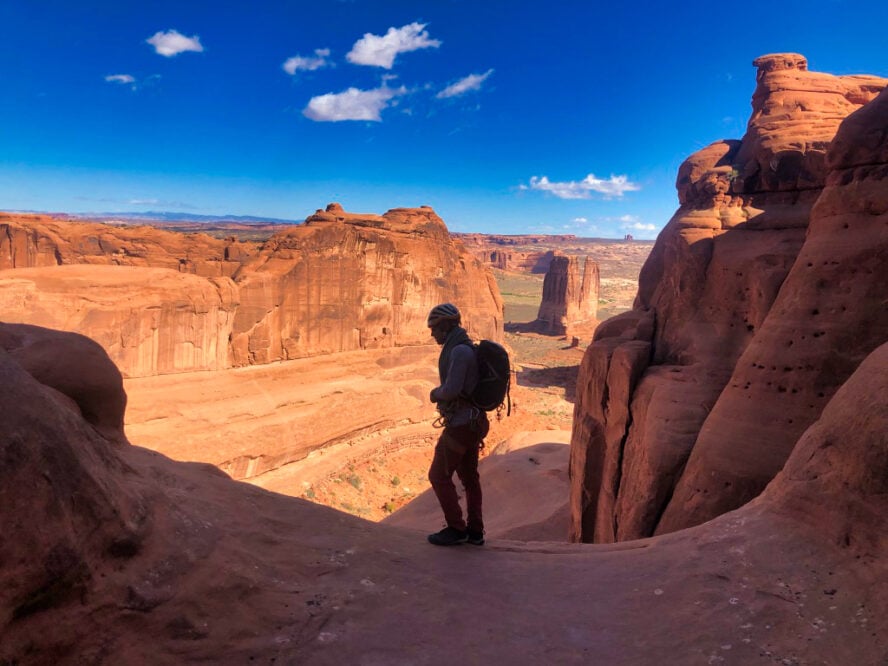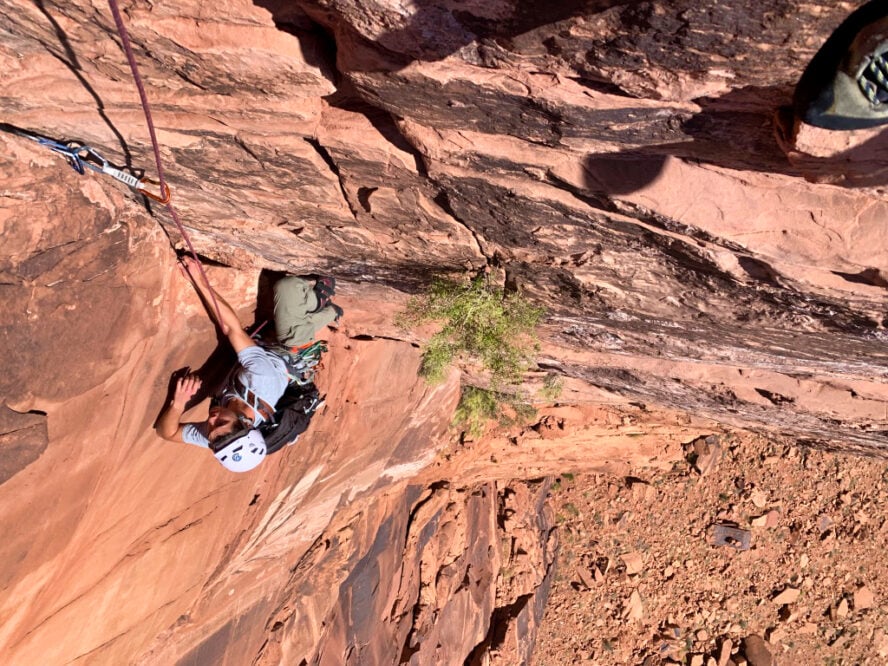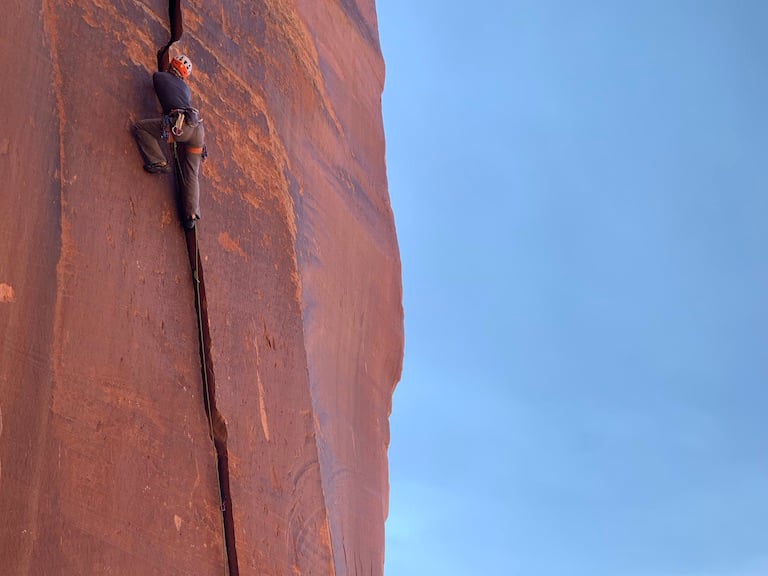Picture a thin, long splitter, like a rope cast from the heavens, carving its way up a massive sandstone tower. Behind it stands a canyon rim where a fiery rock arch frames the desert sagebrush and the snowy peaks rising out of a meandering red river in the distance. This is a typical scene on the Colorado Plateau—and at the heart of this otherworldly landscape is Moab, Utah — one of the ultimate USA climbing destinations.

Pros and Cons of Climbing in Moab
A brief background of Moab
Why is Moab called Moab? The biblical name Moab refers to the land located just short of the Promised Land. An ancient kingdom described as a green, lush valley surrounded by harsh desert, it’s easy to see why Mormon pioneers named this area Moab.
Located on the Colorado Plateau, the Moab area (as defined by climbers) stretches from Interstate 70 in the north, past Dead Horse Point State Park and Arches National Park to the small town of Monticello in the south, and then from Castle Valley and the La Sal mountains in the east to the western edges of Canyonlands National Park. Check it out on a map; it’s HUGE!
The type of rock in Moab
Moab is made up of various sandstone formations, like the Chinle Formation, which you will come to know well as you hike up the talus cones to the base of your favorite Wingate climb. The mud coated Fisher Towers are a series of towers made primarily of soft Cutler sandstone.

Above these are the Kayenta and Navajo formations, which predominantly make up Arches National Park and much of the canyon rims around the Colorado River and Indian Creek alongside the Temple Cap and Carmel formations. Higher still, in the La Sal Mountains, a mash of Permian gray limestone is sandwiched between hard layers of Triassic Woodside shale that make up a large part of the sport climbing area of Mill Creek Canyon.
What to bring for gear
Moab’s rock climbing is as varied as the rock formations themselves, which is why it tops the list as the best place for climbing in Utah. You’ll want a mountain of cams in all sizes, so bring yours and all your friends’ cams to protect the parallel-sided splitter cracks of the Wingate sandstone. Don’t forget your jumars and etriers for the exciting, muddy aid climbs of the Fisher Towers. You may also want to pack a substantial rack of quickdraws for the well-protected slopers, pockets and jugs of the Theater and the Cinema or the hard, sustained crimping of Mill Creek. Heck, you may as well throw in light static lines for all the canyoneering you will want to do on your rest days! Depending on the area you are going to, this combination of gear may vary or combine, so let’s look at the best areas to get the best of Moab!
A brief note on Leave No Trace
Moab is a sensitive environment that’s heavily trafficked. To ensure the longevity of this magical place, we need to evolve past some out-dated practices and be responsible. Here are some Leave No Trace principles to consider:
Wet rock is not climbable rock. Moab is mostly soft sandstone that is easily damaged by ropes, chalk and the act of climbing, especially after rain. It is a common practice to wait up to three days after a significant rainfall (one measured in inches) to climb. Please respect this. Learn to read the ground for water and feel the rock for any signs of moisture. Typically, if the route receives sun and wind for significant portions of the day, it will dry much sooner than rock in the shade. For shaded rock, if the ground is still damp on the surface, the rock is likely too wet to climb.
Use rock-colored chalk. Be aware that chalk stands out against the red rock and is often the first thing you may notice about an area. The public and land managers often see this as an eyesore, and in some places such as Arches, the mandate is that climbers use rock-colored chalk (which can be purchased at any gear shop in town).
Pack out your poop. If you are not near a pit toilet, then you must carry a sanitary waste bag that can be packed out and disposed of in a proper waste receptacle. We are far past the time of burying our poop in the desert!
Respect wildlife. Be aware of raptor closures and other types of wildlife restrictions. It is advisable to check local climbing organizations such as The Friends of Indian Creek for all current closures. Please consider supporting the local climbing shops and organizations that keep this place clean and up-to-date with proper hardware!
1. Arches National Park
Sitting above Moab on a high plateau, lies the majestic vista that is Arches National Park. One of the most popular parks — and one who’s iconic Delicate Arch is portrayed on Utah license plates and bumper stickers the world over — it is genuinely cerebral to climb in such a location! The rock here is a mixture of Entrada, Wingate, Navajo, Curtis and Carmel formations. The landscape is a swath of varying sized tower groups that call out to be climbed. Arches isn’t one of my more frequented spots, but I have enjoyed each objective I have done there.

My favorite Arches climbs
The first tower I climbed was Owl Rock. This moderate 5.8 is enjoyable, steep and well-protected. At 5.10b C1, the Golf Ball makes a great adventure outing to a spectacular summit. Zenyatta Entrada climbs a beautiful line up the Tower of Babel, located above the road and one of the first spires you see when driving into the main area of the park.
It needs noting that many formations are off-limits to climbers, especially Delicate Arch. Ask the rangers at the visitor center if you are unsure which areas are no-climb zones. Also, white chalk is illegal in Arches National Park. Use rock-colored chalk, which you can purchase at any gear store in town.
2. Castle Valley
Not much needs to be said about Castle Valley as climbing lure is rife with amazing history in this must-visit location. Located only a half-hour east of Moab along River Rd (UT HWY 128), a visitor to the Moab area has access to some of the most majestic towers in the US, on par with the climbing in Devil’s Tower. The view along the famous skyline of Castleton Tower, the Rectory, The Priest and the Sister Superior group stand in many climbers’ minds as the embodiment of rock climbing. Routes such as the North Chimney and the Kor-Ingalls (one of America’s 50 classics) on Castleton and Fine Jade on The Rectory are the mains draws here. Jah Man on Sister Superior is also up there on my list of favorites.
3. The Fisher Towers, Titan’s Finger of Fate and Ancient Art
Just a bit further up the road stands the strange outcropping towers of the Fishers. People talk about The Fisher Towers with both disdain and awe. The towers are comprised of disturbingly soft sandstone and coated in a layer of mud (that you’ll be finding on your gear a year later), but keep climbers coming back because they offer some of the most spectacular summits of any towers anywhere.

The Titan’s Finger of Fate stands as an aid or free test piece involving engaging gear management as well as being continuously steep. The much more traveled Ancient Art Formation, commonly approached by the Stolen Chimney route, is the main draw here. However, I enjoy beating the crowds and heading to Kingfisher and climbing Colorado Northeast Ridge.
4. River Road
As I drive up to Castle Valley, I’m constantly distracted by the continuous walls that line the meandering Colorado River on both sides. I have my preferred circuit on River Road, and it typically begins at River Road Dihedrals with a quick warm-up on routes such as Root Canal and Bloody Elbows. Then, I like to head upriver to the Utopia area to get in a couple of small towers and a rim route. Routes like Terma (a rim route) gracefully clips bolts and contains one final pitch of gear before the rim. Back on the ground, two moderate towers (only 50ft tall) called Spear of Destiny and Tjurunga offer a nice romp after your rim route.
The best sport climbing
Hopping back in the car, I cruise over to the Cinema and the Theater. For Moab sport climbing, it’s hard to beat this destination! The Cinema offers amazing, tall moderates from 5.7 to 5.10. Bring your 70! Men in Tights and Adventures in Babysitting are the draw to warm up to this exciting area with a quick move over Encore, a beautiful 5.11 arete. On over to The Cinema, I love wrapping my time up there with An Overflow of Good. At mid 5.11, this long and pumpy, well-protected route is the perfect end to a tiny sport climbing adventure.
5. Big Bend Boulders
Having little gas left in the tank, literally and figuratively, I drive back downriver to the Big Bend Boulders. This group of roadside boulders offers one of the easiest approaches of any bouldering area. Two favorite climbs of mine are Brown Power (V4) on the Block Top Boulder (which is all body tension on squeezing crimps) and Slots of Fun on Black Box. Afterwards, it may be prudent to watch the sunset, or snag the Lonely Vigil route on Lighthouse Tower to get an even better look!

6. Potash Road
Following the Colorado River down its winding path to the western side of town, I drive west on Potash Road, where the walls quickly close back in from the open-air vistas around Moab. First up is Wall Street. Accurately named, this roadside venue offers the chance to park right next to your project and literally belay from your car. Just be careful when your climber falls and pulls you out of the rig! A warm-up on Potash next to the Petroglyphs above the road provides a decent taste of the slopey, slick nature of the rock here.
7. Day Canyon
Routes like Static Cling demonstrate the need to utilize red chalk here as the chalk stains are plentiful! Watch out for pedestrians and drive this area slowly. Just down the river, you’ll find Day Canyon. A seemingly innocuous side canyon leading west off of the right side of the road, this spot is host to one of the best Moab sport climbing routes, right at the mouth of the canyon. The 5.10c Pocket Rocket is a wonderful jug haul through conspicuous huecos to the chains.

8. The road to Maverick
Deeper in the canyon are some of the best splitter cracks in Moab: Christine’s Way Buff Sabb and Brush Painted Datsun. At 5.9 and 5.10, respectively, these excellent hand cracks give you the feeling of solitude as well as a sense of awe at how this canyon came to be from such a small trickle. Back to the car and just a bit further down Potash, past Jug Handle Arch, lies the road to Maverick — one of the highest concentrations of splitters close to Moab.
Located in Long Canyon, recent upgrades to the road have made it passable by all but the lowest clearance passenger cars. At this crag, I am astounded by the thin, big hand lines of routes like Tequila Sunrise and Miss Kitty Likes it That Way. On the way back to town on Potash, are some incredible sport routes at Mars. For some hard, crimpy climbing, this is the place to be to earn your rest day, which I certainly did the first time I hopped on Hubble (5.11+).

9. Mill Creek
If you’re like me and arrive to the Moab area in October, temperatures can still be quite hot. Mill Creek offers an escape to cooler temperatures and some bolts to clip, but don’t confuse this area with the Red River Gorge. The bolt ethics here have a traditional feel and often protect the hardest moves, but can be quite sparse on the “easier” climbing in between.
I was first introduced to the area by a friend who knew how to get around Mill Creek quite well — something I came to appreciate! She took me to an area called Sunny Side, which is just across “the log.” With a well-protected 5.8 and a stellar 5.10 called Magic Carpet Ride, this was a great, soft introduction to Mill Creek climbing. Mill Creek is crimpy with a lot of balancey, thin movement. Don’t get me wrong; there is plenty of steep climbing here at areas like Wicked Crag, but I’ve come to appreciate that Mill Creek is a great place to make my fingertips strong!
10. Indian Creek
I must admit, I have a large bias towards “the Creek.” It holds a special place in my heart after my first time climbing Generic Crack and feeling that first-hand jam that was so solid! If you’re looking for the splitter cracks, it’s a world-class mecca for such an endeavor. Containing several lifetimes of cracks of all sizes, Indian Creek has something for everyone.
The mistake I made when climbing in the Creek for the first time was focusing on grades. When discussing a crack, one should merely use a grade as a barometer, understanding that it is hand and body size-dependent! Beginning at handcrack sizes (5.10), and becoming harder as we move to either end of the size spectrum from tips fingers to offwidth, it is easy to see the grade and make assumptions. However, with smaller hands, I find that the size of the gear is a better metric. I find a perfect Black Diamond #2 Camalot an ideal hand. I advise being open-minded and take the time to find the size that works for you and learn to speak in that language.
The towers of Indian Creek
There are even towers in the Creek! The North and South Sixshooters dominate the skyline when passing Scarface as you drive into the area. Lightning Bolt cracks on North Sixshooter and the South Face of South Sixshooter make great summit routes. The Bridger Jacks offers up some stellar tower link-ups along its jagged skyline. My favorite tower is Easter Island via the Thunderbolts route.

Don’t forget to bring your friends when climbing in Indian Creek… and lots of them! A good Creek rack may consist of five, seven, or even 10 to 12 pieces of the same size! It is advisable to combine racks with friends you made while camping at Creek Pasture. Good pieces to have are Black Diamond Camalots, Wild Country Friends, and Metolius cams (the black is my personal favorite).
Guide services
Moab rock guides are an incredible resource for the visiting climber looking to have a big experience, whether learning to crack climb or desiring an adventurous tower, deep in the desert. Want to have a full tower progression ending in the summit of a famous desert tower? Want to learn how to transition your skills from gym to crag? Maybe a customized day with a guide is more your speed.
If you’re heading to Moab to place your body parts into the many sizes of cracks it has to offer, consider a crack clinic.
What is the best time of year to go to Moab?
With many different elevations to climb at, Moab offers year-round adventures. From summertime climbing in the Abajos and La Sals, down to Potash Road and Indian Creek in the winter, one can visit any time. Most will want to visit Moab from late September, as things begin to cool off and climb through mid-November.
My favorite time is October to witness the changing of the season, where the colors are glorious. This is often the wettest month though, so be prepared to not climb on the wet sandstone. In the spring, I find that March through May is a great time to find a bit more solitude than the crowded fall. Moab’s climate is semi-arid, so rainfall is more sparse, but due to its proximity to the Rockies and its rather high elevation beginning around 5,400ft, it can experience mountain weather at any time.
Camping in Moab
You’re not climbing in Joshua Tree; Overnight camping in the city of Moab is not allowed, so when one is visiting, it is prudent that you pick an appropriate place to stay. Don’t be trying to dirtbag it in the City Market lot!
That said, there are plenty of options to be had. Just like Red River Gorge, camping in Moab, Utah, can be as easy as driving on to BLM land far outside of town or finding a tucked-away place in a private or BLM campground along the river. Where you camp will depend on the area you plan to climb at, and it’s all governed by an interesting patchwork of land managers.
I highly recommend paying the extra money for Gaia and utilizing the hunting layer, which will show you land ownership of a given area. Most Forest Service and BLM areas are free to dispersed camping, however, it is best to ask around for the final answer. I often check in with the BLM field office in Moab. They are always happy to help answer these questions!

The best camping spots
Good paid camping areas include Upper Onion Creek Campground near Castle Valley and Upper Big Bend Campground. On Potash, one can find King’s Bottom at $20 per night, which is nearest to Wall Street, or Gold Bar at $20 per night, nearest to Day Canyon. In Mill Creek, it is possible to camp in your car at just about any gravel pull-off as this area is mostly on Forest Service Land. In Indian Creek, one can stay at Super Bowl or Creek Pasture for $15 per night. I prefer the Bridger Jack and Cottonwood campgrounds because they are a bit quieter. It’s worth noting that these latter two do not have pit toilets, and solid waste must be packed out. Please camp only in established areas. Do not trample cryptobiotic soils or sagebrush.
The Moab Craggin’ Classic
Every year, the American Alpine Club invites locals and visiting climbers to enjoy several popular areas around the country in an event centered around education, fun, friends and service. Occurring every October, the Moab Craggin’ Classic seeks to bring climbers of the local area together to develop a family of fun and service for three days. With clinics for all skill levels, giveaways, raffles, climbing films, parties and plenty of fellow climbers, this event is the perfect time to be a part of the Moab climbing scene. Stay for day three to do some service work that will help you give back to this amazing climbing resource!
If you’d like to join a similarly social but more frequent event, rock climbing camps are a great way to see Moab, develop new skills, and connect with future belay partners.
Want to learn more about climbing in Moab? Listen to AMGA guide Izzy Lazarus reveal what she loves about Moab and what makes it the perfect venue for an all-women’s weekend climbing camp in this 57hours Adventure Talk:






